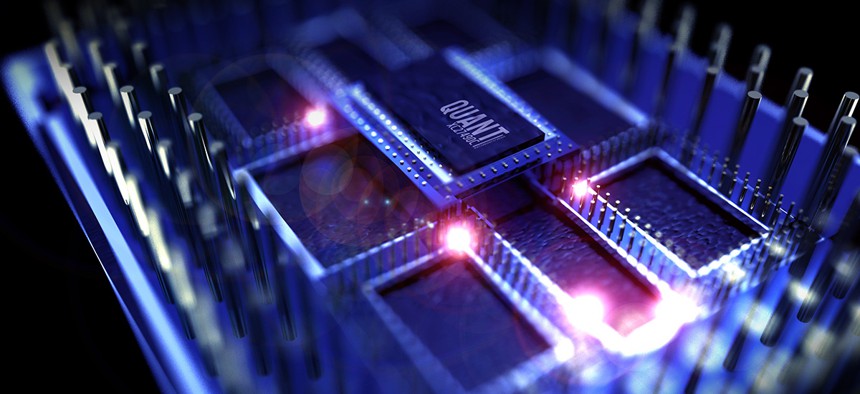Physicists Have Created 'Impossible' State of Matter That Could Power Quantum Computers

welcomia/Shutterstock.com
Quantum computers are predicted to be faster than any supercomputer that can be built with silicon chips.
The laws of physics are supposed to be symmetrical in time and space. That means a ball thrown at a certain speed and in a certain direction would always go the same distance, no matter when you throw or where on Earth you throw it (assuming no other factors, like weather, came into play).
There are, however, things that do break space symmetry. Magnets have north and south poles, which means the magnetic spins of atoms within a magnet are not, as would be expected, spread in all directions but aligned in one direction or another. The same is true of crystals. Though fixed in space, some atoms in a crystal have preferred positions, which makes them appear different based on where you observe them from.
Time symmetry, however, never breaks. The Nobel Prize-winning physicist Frank Wilczek noticed this and started asking questions.
What if, for example, you threw the ball once at 12pm on Friday, and then again at 10am on Tuesday, at the exact same speed in the exact same conditions—and the two throws went a completely different distance? Wilczek knows that, in the macro world, that wouldn’t happen. But as Albert Einstein once pointed out, things get “spooky ” at the atomic level. In 2012, Wilczek proposed that perhaps at the atomic level it would be possible to create a type of matter that broke time symmetry; he called it a “time crystal.”
The idea kicked off a storm of interest. Soon, however, calculations by Masaki Oshikawa at the University of Tokyo showed that time crystals would be impossible. His team found any system in the lowest energy state and in equilibrium would not be able to break time symmetry.
By equilibrium, physicists mean all molecules of, say, water in the liquid state have at least a certain amount of energy. If you add energy in the form of heat to liquid water, all the molecules that gain a certain amount of energy will reach a new equilibrium, becoming steam and enter a new state of matter. Every distinct state of matter we know about is in equilibrium.
However, if physicists could get matter to enter a nonequilibrium state, they could also, based on Oshikawa’s calculations, make time crystals. If they do, it would be a hitherto unknown state of matter. The trouble was physicists didn’t know how to do it—until now. Two studies published in Nature March 9 show such nonequilibrium states can be entered and matter in those states can be classified as types of time crystals.
Christopher Monroe, a physicist at the University of Maryland-College Park, created the system using 10 charged atoms of the element ytterbium and four sets of lasers. One laser converted each ytterbium atoms into a magnet. Another laser naughtily caused disorder to ensure the atoms were in a nonequilibrium state. Then, a third laser made the magnetic atoms to flip—as if the north pole switched to the south pole in a large magnet.
The combination of these three lasers (the fourth was used to read the status of each atom) caused the atoms to oscillate, but at twice the frequency at which their magnetic states were being flipped. In other words, it broke time symmetry.
“It’s like playing with a jump rope, and somehow our arm goes around twice but the rope only goes around once,” Yao told Nature.
Mikhail Lurkin, a physicist at Harvard University, also created a time crystal but in a different system. He used a “dirty” diamond, which is like a normal diamond but has lots of nitrogen atom impurities. He used microwave pulses to flip the spins of nitrogen atoms—and, it turned out, just like Monroe’s ytterbium atoms, the frequency at which the atoms flipped their spin different from the frequency of the pulses.
The time crystals created by Monroe and Lurkin are slightly different than the ones Wilczek proposed. They require regular inputs of energy, which Wilczek’s time crystals would not have needed.
“It’s less weird than [Wilczek’s] idea, but it’s still fricking weird,” Yao told Nature.
Because of this difference, not everyone is convinced what the physicists have achieved are actually time crystals.
“This is an intriguing development, but to some extent it’s an abuse of the term,” Oshikawa told Nature.
The creators of the newly announced time crystals aren’t fussed about definitions. They are, instead, excited by the possibility of using their methods to accelerate the development of quantum computers, which are predicted to be faster than any supercomputer that can be built with silicon chips.
Quantum computers require atoms to exist in entangled states, where changing the state of one automatically causes the other to change state too. At present, such states can be achieved only at extremely low temperatures. Lurkin got all the nitrogen atoms in his dirty diamond to change position together at a constant frequency—meaning they were held in quantum entanglement—and he did it at room temperature.
“In my main job, I use atoms to create quantum computers,” Monroe told me. “Our finding could help create larger quantum computers that don’t need to be at such cold temperatures.”





